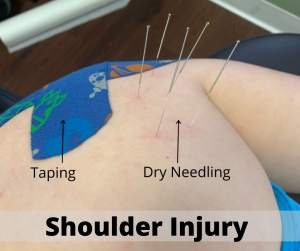Dry Needling
History of Dry Needling

Back in the 1930s a professor at Cornell Medical school read new research on the theory of trigger points and referred pain. She began experimenting with injecting varying substances into her shoulder to treat her persistent arm pain. It was found that relief did not come from WHAT was injected, but the needle itself that provided relief. After a few years of going around repeatedly stabbing folks with hypodermics causing infections and creating scars; some dude in Canada proposed the following. Instead of using large gauge, large-bore needles, why not try small gauge monofilament (acupuncture) needles? Thus, the birth of Dry Needling.
Is Dry Needling and Acupuncture the same thing?
I am only going to say this once, so listen up. Dry Needling is NOT Acupuncture and Acupuncture is NOT Dry Needling. The only similarity is the tool, and that is because the needles are easy to make and are hygienic. It is like saying Italian and Thai are the same because they both use noodles.
Here is the weird thing. For the longest time, Dry Needling was only considered to be a diagnostic procedure. If you stuck a needle in a painful area and the pain went away; then that area was responsible for the pain. What you were to do with that information no one knew. Except that it made the pain go away. Subsequently, Dry Needling was adopted as an “off the books” treatment. Many thought of it as a little Wild West when it came to treatment protocols. In the past few years, it has become more mainstream and many providers are recommending Dry Needling instead of medications. If we learned anything from Warren G, it is that regulators like to regulate. This year, most states have adopted definitive sets of rules regarding the who, what, when, where, and why of treatment. And Maryland being Maryland, the rules here are among the stringiest.
Guess who has got 2 thumbs and is one of the first certified Dry Needling providers in the State? If you guessed ‘this guy,’ then you are right.
_______________________________________________________________________
It worked for Mrs. Spine:
Of course, I try treatments out on her because she is not afraid to tell me what she thinks. She had an issue where she had unexplained arm pain, specifically in her wrist. It was getting increasingly worse over a few days until she could not hold a hairbrush, use a mouse, type, or even open a door handle. We could not remember any type of injury that would cause wrist pain at all. Further examination of the area there was nothing wrong with her wrist. So, I moved up her arm ad when I got up right below the elbow, she started complaining that it hurt worse. We then remembered she had been carrying a laptop, a large one, in a bag on her shoulder and it fell, she caught it on her arm right below the elbow. Exactly where I was touching now. We tried Dry Needling. After one treatment pain was significantly better after a few treatments no pian at all. Now every injury does not get better this fast. This injury was small and she got treatment right away. But Dry Needling can be an effective tool in your treatment plan.
_________________________________________________________________________
Frequently Asked Questions
Do the needles hurt? These needles are so thin that most often you do not feel them at all. What you do feel is the plastic guide sleeve that touches your skin. You can not feel the insertion or removal of the needle.
Really, no pain? Most often no. However, if there is extreme pain like in Mrs. Spine’s story the area was so sensitive and inflamed that area hurt to be touched by anything. But after treatment the relief was immediate.
I can’t do blood is there blood? In most cases no. Sometimes there may be a small spot but once cleaned up with an alcohol wipe it’s all gone. Significantly less than a paper cut.
Is it safe? Absolutely. All treatments products and services we offer in our office we use on our family even our kids!
How many needles do you use?
That depends on the area and what is wrong. Could be as little as 1-3.
